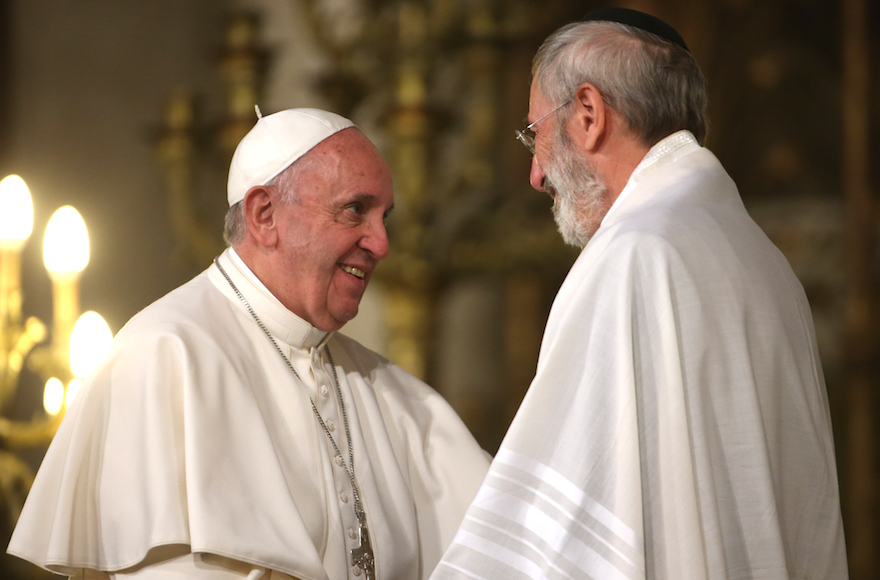Pope Francis must insist Auschwitz church be moved
Published July 28, 2016

Pope Francis, left, greeting the chief rabbi of Rome, Riccardo Di Segni, during a papal visit to the city’s synagogue, Jan. 17, 2016. (Franco Origlia/Getty Images)
(JTA) — This week, Pope Francis will be making a pilgrimage to Poland, visiting Auschwitz – the notorious death camp in Poland where 1.1 million Jews were murdered during the Holocaust. Auschwitz is comprised of two camps: Auschwitz I and Auschwitz II, also called Birkenau. Birkenau is the actual “theater of death,” where the vast majority of Jews were murdered.
ADVERTISEMENT
At Birkenau, there is a large church in what once was the Nazi commandant headquarters. The church is in direct violation of a 1987 agreement signed by four European cardinals and European Jewish leaders that declares “there will be no permanent Catholic place of worship on the site of the Auschwitz and Birkenau camps.” Pope Francis must recognize this affront and ask that the church be moved.
This is not the first time that a Catholic place of worship was established at Auschwitz. In 1984, Carmelite nuns took over a building at Auschwitz I that once stored the Zyklon B gas used by the Nazis to murder Jews. With the full support of Polish Cardinal Franciszek Marcharski, local authorities granted the nuns a 99-year lease to convert the building into a convent, where the nuns sought to pray for the souls of the murdered. It was around this time that the local Catholic community established the church at Birkenau, called the Parish Church of Brzezinka.
As a rabbi, I have deep respect for all places of worship. I also feel that Christian houses of worship do not belong at what is in effect the largest Jewish cemetery in the world. And so in July 1989, I joined a group of seven activists protesting the Carmelite convent. We climbed over the fence surrounding the convent and peacefully assembled. Polish workers inside the convent poured a bucket of water mixed with urine on us as nuns watched from the windows. In 1993, Pope John Paul II himself ordered the nuns to leave and the convent was shut down.
Though that closure was a victory, the larger affront, the Birkenau church, remains. A former priest, James Carroll, eloquently describes this offense in his book “Constantine’s Sword: The Church and the Jews,” writing, “When suffering is seen to serve a universal plan of salvation, its particular character as tragic and evil is always diminished.
“[T]he elimination of Jewishness from the place where Jews were eliminated,” Carroll continues, makes “the evil worse.”
ADVERTISEMENT
And so in 1995, on the 50th anniversary of the liberation of Auschwitz, I again joined activists, this time for a sit-in at the Birkenau church. After a standoff with church officials that lasted throughout the day, we were arrested and taken to a police station, where a doctor summoned there asked that we strip. Flabbergasted, I blurted out, “You mean you haven’t stripped enough Jews in this place?” We were held for several hours before being released. Our protest and arrest won no concessions from the church or Catholic hierarchy.
The church remains, and its very existence at this sacred Jewish space is inappropriate, misleading and a violation of Shoah memory. A hundred years from now people will look to the camp for evidence of what occurred there. If the church structure remains, its large cross casting a shadow over Auschwitz II, the site could suggest to the uninformed that the Holocaust was either an attempt at Christian genocide or that the church defended Jews at that time – when in fact the church turned its back on the large-scale attempted annihilation of the Jewish people.
If we as a humanity are to learn from our history, to strive for a better future, we need to know what has passed before us. Otherwise, we perpetuate the possibility that the atrocities of the past will repeat in the future and untold suffering will prevail.
It’s up to people of moral conscience to raise a voice for the sake of Holocaust memory and declare loud and clear: A church has no place at Auschwitz II. As Pope John Paul II moved the Carmelite convent, Pope Francis – who has shown himself to be a great friend to the Jewish community – has the power to order the Birkenau church be moved. The building should become a museum, specific to Birkenau, showing how the Nazis carried out their atrocities there. The large crosses in front of and on top of the building should be removed. The memory of the Jews murdered there — murdered because they were Jews — must be recognized with historical accuracy.
With each passing year, fewer survivors remain. The time is not far off when there will be no living witnesses to share their part in this story, to say: Yes, this happened, and this is how. We cannot allow evidence of the Holocaust to be co-opted by other groups for other purposes.
(Rabbi Avi Weiss is the founding rabbi of the Hebrew Institute of Riverdale-the Bayit, and founder of Yeshivat Chovevei Torah and Yeshivat Maharat. He is also the co-founder of the International Rabbinic Fellowship.)















